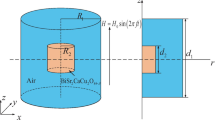A theoretical and experimental study is presented of the influence of thermally activated flux creep on the ac response of a type II superconductor in the mixed state. The theory describes the ac response of a cylindrical superconductor in the mixed state in an axial dc magnetic field and a superposed parallel ac field of low amplitude and low frequency. Thermally activated flux creep gives rise to flux motion at the peak and the valley of the sinusoidal ac applied field and a frequency-independent phase shift of the voltage induced in a pickup coil wound about the sample. The instantaneous voltage at the peak or valley of the ac applied field is related to the critical-current density J c and the pinning-energy barrier normalized by the temperature U/kT. The ac loss voltage and the voltage waveform were measured for a cold-worked NbZr sample. For temperatures T below 4.2 K, the measured values of kT/U are nearly proportional to the temperature. Both J c and U were observed to depend on magnetic field history.
Similar content being viewed by others
References
C. P. Bean, Rev. Mod. Phys. 36, 31 (1964).
R. W. Rollins, H. Küpfer, and W. Gey, J. Appl. Phys. 45, 5392 (1974).
J. F. Wagner and R. W. Rollins, J. Appl. Phys. 44, 1778 (1973).
P. W. Anderson and Y. B. Kim, Rev. Mod. Phys. 36, 39 (1964).
M. R. Beasley, R. Labusch, and W. W. Webb, Phys. Rev. 181, 682 (1969).
Y. B. Kim, C. F. Hempstead, and A. R. Strnad, Phys. Rev. Lett. 9, 306 (1962).
Y. B. Kim, C. F. Hempstead, and A. R. Strnad, Phys. Rev. 131, 2486 (1963).
R. A. Anderson and D. M. Ginsberg, Phys. Rev. B 5, 4421 (1972).
H. Boersch, B. Lischke, and H. Söllig, Phys. Stat. Sol. (b) 61, 215 (1974).
G. Antesberger and H. Ullmaier, Phil. Mag. 29, 1101 (1974).
J. M. A. Wade, Phil. Mag. 20, 1107 (1969).
J. E. Nicholson, B. S. Cort, and G. P. Cort, J. Low Temp. Phys. 26, 69 (1977).
J. I. Gittleman and B. Rosenblum, Phys. Rev. Lett. 16, 734 (1966).
J. R. Clem, H. R. Kerchner, and S. T. Sekula, Phys. Rev. B 14, 1893 (1976).
S. T. Sekula, R. H. Kernohan, and E. S. Cantrell, Rev. Sci. Instr. 42, 1187 (1971).
H. Küpfer and W. Gey, Phil. Mag. 36, 859 (1977).
A. M. Campbell, J. Phys. C 2, 1492 (1969).
A. M. Campbell, Phil. Mag. B 37, 149 (1978).
S. T. Sekula and J. H. Barrett, Appl. Phys. Lett. 17, 204 (1970).
E. J. Kramer and A. Das Gupta, Phil. Mag. 26, 769 (1972).
Author information
Authors and Affiliations
Additional information
Research sponsored by the Division of Materials Science, U.S. Department of Energy, under contract W-7405-eng-26 with the Union Carbide Corporation.
Rights and permissions
About this article
Cite this article
Kerchner, H.R. The influence of thermally activated flux creep on the ac response of a hard superconductor. J Low Temp Phys 34, 33–52 (1979). https://doi.org/10.1007/BF00118548
Received:
Issue Date:
DOI: https://doi.org/10.1007/BF00118548




